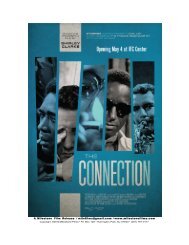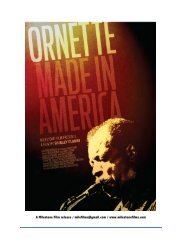ORNETTE Press Kit.8.7.2012 - Shirley Clarke
ORNETTE Press Kit.8.7.2012 - Shirley Clarke
ORNETTE Press Kit.8.7.2012 - Shirley Clarke
- No tags were found...
Create successful ePaper yourself
Turn your PDF publications into a flip-book with our unique Google optimized e-Paper software.
Dancer as Filmmaker: The Cinematerpsichorean World of <strong>Shirley</strong> <strong>Clarke</strong> by KATHELIN HOFFMAN GRAY Though <strong>Shirley</strong> <strong>Clarke</strong>’s name is not known to the average moviegoer, filmmakers such as Ingmar Bergman, Godard, Agnes Varda and Otto Preminger regarded her as one of the most influential directors in film history. Scorsese’s first sequence in Michael Jackson’s Bad was inspired by <strong>Clarke</strong>. What is seldom discussed is the importance of dance in forming her aesthetic and her experimental breakthroughs. <strong>Clarke</strong> began her career as a choreographer and dancer, and brought a dancer’s sensibility into film in the 1950’s and 60’s, and then into the evolution of video, creating new cinematic expressions of time and space. She was born <strong>Shirley</strong> Brimberg in New York City in 1919 to wealthy immigrants. Like her inventor grandfather, she was an ambitious innovator. On a mission to escape her tyrannical father, <strong>Clarke</strong> took advantage of New York’s intellectual and artistic accessibility and discovered modern dance, which was open to women as creators. No ballet for her, she was drawn to the excitement of modern dance, to “free” dance, and at age 14 she aspired to become the next Martha Graham. She trained in the Graham method, the Doris Humphrey-‐Charles Weidman technique, and went on to study with Hanya Holm. Thus the Dalcroze emphasis on physical awareness and sensual experience of music guided her subsequent evolution as a filmmaker. She had validation of the intelligence of her body. Through Dalcroze methods, she learned experience of rhythm, which later became the core of her creative process as director and editor. She was kinetic physically and mentally, with a dancer’s body and a quick and prolific intellect. <strong>Clarke</strong> would say in the ‘80’s, ‘I cannot pay attention to or remember anything that does not move.” The dance world gave more recognition to women, and this fuelled her ambition. That her father forbade her to become a dancer only encouraged her. She developed sympathy for the ‘underdog’: women, black culture, artists, drug culture, and everything that was anathema to the wealthy and prejudiced high society in which she was raised. She formed an idiosyncratic feminist politics that drove her life: as she would say, a ‘gentle anarchy.’ “There's no question that my career would have been different if I was a man, but if I were a man I would be a different human being." In her early 20’s, she slowly realized that she would never be the next Martha Graham. She turned to filmmaking, and began with dance films. <strong>Clarke</strong> wanted above all to succeed. She never discussed her failures, so she never shared anecdotes about her life as a young dancer, not even with her daughter Wendy. However, she did love to speak of her affair with the Indian contemporary dancer, Uday Shankar, brother of musician Ravi. She moved on, but dance was in her for good. 28




